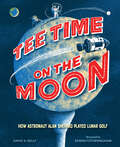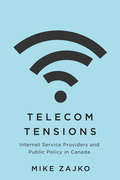- Table View
- List View
Tecnología espacial en el espacio y en la Tierra (¡Arriba la Lectura! Level V #68)
by Cara TorranceNIMAC-sourced textbook <p><p> Las tecnologías para viajar por el espacio son asombrosas. Y muchas de esas tecnologías se han adaptado para usar en la Tierra. <p> Los paneles solares que dan energía a las naves espaciales se usan ahora para dar energía a los hogares. Los plásticos protectores con los que se fabrican cascos de astronautas se usan ahora en las lentes de los anteojos que usamos todos los días. Estas y otras tecnologías importantes que usamos en la Tierra quizá no existirían si no fuera por los desafíos particulares de viajar en el espacio.
Tee Time on the Moon: How Astronaut Alan Shepard Played Lunar Golf
by David A. KellyAstronaut Alan Shepard's mission: Fly to the moon. Study it in more detail than ever before. Hit a golf ball in low gravity. But how far? Find out in this engaging STEM/STEAM picture book.In 1971, Alan Shepard and his fellow astronauts made their way to the Moon in the cramped Apollo 14 capsule. Their mission: Study the moon in more detail than ever before. While the world watched on TV, Shepard and Edgar Mitchell gathered rock and soil samples wearing stiff, heavy spacesuits. But Alan Shepard had a secret hidden in his sock: two tiny golf balls. Golf was Shepard&’s favorite sport. And since the moon has virtually no atmosphere and gravity that is only a fraction of the Earth&’s, a golf ball should have been able to go far. But did it?Here's the little-known but true story of an experiment that may have started as a stunt, but ended up making people think differently about the moon, ask questions, and look for answers.
Teen Health Course 3
by Michael J. Cleary Betty M. Hubbard Glencoe StaffA textbook that provides insights into healthy living and a total lifestyle change for a happy long life. It covers the following topics in-depth. Understanding Your Health Skills for a Healthy Life Mental and Emotional Health Mental and Emotional Problems Relationships: The Teen Years Promoting Social Health Conflict Resolution Violence Prevention Physical Activity and Fitness Nutrition for Health Your Body Image Alcohol Tobacco Drugs Personal Care and Consumer Choices Your Body Systems Growth and Development Common Communicable Diseases Noncommunicable Diseases Safety and Emergencies Environmental Health
Teen Innovators: Nine Young People Engineering a Better World with Creative Inventions
by Fred EstesA water purification system made of concrete and the same chemicals that block ultraviolet light in sunscreen. A robot made of PVC pipe that beat a shiny, eleven-thousand-dollar competitor in a robotics contest. An electricity-producing windmill built by a teen who taught himself physics by candlelight. <P><P> Teen Innovators: Nine Young People Engineering a Better World with Creative Inventions reveals how people of any age or experience level can create something that changes others' lives through nothing more than hard work, creativity, and inspiration. (Oh, and perhaps a bit of electrical wire, some plastic piping, and a couple tampons.) Utilizing the principles of design thinking, these inventors all tinkered, experimented, and failed—repeatedly—until their inventions worked. The windmill produced light. The water became safe to drink. <P><P> Jack Andraka: improved pancreatic cancer test <BR> Gitanjali Rao: device to detect lead in drinking water <BR> William Kamkwamba: improvised electrical generator using windmill in Malawi <BR> Austen Veseliza: digital display glove to aid people with speech impairment <BR> Deepika Kurup: easier, cheaper method to remove toxins from drinking water <BR> Cristian Arcega, Lorenzo Santillan, Oscar Vasquez, Luis Aranda: underwater robot <P><P> Each of these stories offers inspiration to the next generation of teen innovators. You don't need a genius-level IQ or the latest and greatest technologies to create something that makes a difference. All you need is an idea and the determination to make it real.
Teens & The Supernatural & Paranormal (Gallup Youth Survey: Major Issues and Tr #14)
by Hal MarcovitzTeenagers have always been interested in the supernatural and paranormal. This book notes that fascination with the world of fantasy is nothing new, and examines modern groups like Wiccans and Goths. Discussion of the supernatural and the paranormal is interspersed with scientific explanations. Many other topics are covered, including angels and the End Times. The book also explores reasons why teens are fascinated with the unseen world of magic and mystery.
Teflon, Post-it und Viagra: Große Entdeckungen durch kleine Zufälle (Erlebnis Wissenschaft)
by Martin SchneiderWas haben Penicillin und Röntgenstrahlen mit Teflonpfanne und Viagra gemeinsam? Ebenso wie Polyethylen oder die praktischen gelben Post-it-notes wurden sie zufällig entdeckt; die Erfolge ergaben sich "nebenbei", bei der Grundlagenforschung oder auf der Suche nach etwas völlig anderem. So mancher Flop im Labor führte so zu Produkten, die aus unserem heutigen Leben nicht mehr wegzudenken sind. Der allgegenwärtige Tesafilm etwa ist letztlich ein verunglücktes Wundpflaster, auf dem man heute sogar Daten wie auf CD-ROMs speichern kann. Und die Teflonpfanne verdanken wir nicht der Raumfahrt, sondern der Suche nach einem neuen Kältemittel für Kühlschränke Diese Geschichten rund um Zufälle in der Forschung, vom bekannten Wissenschaftsjournalisten Martin Schneider lebendig und nuancenreich erzählt, garantieren jede Menge Lesespaß. Die Reise durch drei Jahrhunderte Entdeckungsgeschichte zeigt, dass auch in der Wissenschaft nicht immer alles nach Plan läuft; selbst die besten Forscher brauchten oft ein Quäntchen Glück, um einen Treffer zu landen.
Teilchen, Felder und Kräfte: Ein konzeptioneller Leitfaden zur Quantenfeldtheorie und dem Standardmodell
by Wouter SchmitzDieses Buch bietet einzigartige und umfassende konzeptionelle Erklärungen der Quantenfeldtheorie und des Standardmodells der Teilchenphysik. Wie können fundamentale Teilchen als Wellen im Vakuum existieren? Wie können solche Wellen Teilcheneigenschaften wie z. B. Trägheit haben? Was verbirgt sich hinter dem Begriff der virtuellen Teilchen? Warum und wie üben die Teilchen Kräfte aufeinander aus? Und nicht zuletzt: Was sind überhaupt Kräfte? Dies sind einige der zentralen Fragen, auf die die Quantenfeldtheorie und das Standardmodell der Teilchenphysik faszinierende Antworten geben. Leider sind diese Theorien hochgradig mathematisch, so dass die meisten Menschen - sogar viele Wissenschaftler - nicht in der Lage sind, ihre Bedeutung vollständig zu erfassen. Dieses Buch entwirrt diese Theorien auf eine konzeptionelle, nicht-mathematische Weise, indem es mehr als 190 Abbildungen und ausführliche Erklärungen verwendet und dadurch großartige Einsichten vermittelt, die in der populärwissenschaftlichen Literatur nicht zu finden sind. Diese vollständig überarbeitete und erweiterte zweite Auflage bietet bemerkenswerte Einblicke in den Übergang von der Quanten- zur klassischen Welt unter Verwendung des Konzepts der Quantendekohärenz, wobei auch der "Kollaps der Wellenfunktion", der Tunneleffekt und das Quantencomputing erklärt werden.
Teilchen, Felder, Quanten: Von der Quantenmechanik zum Standardmodell der Teilchenphysik
by Gerhard EckerDieses Buch bietet Ihnen eine Einf#65533;hrung in den aktuellen Stand unseres Wissens #65533;ber die Struktur der Materie. Gerhard Ecker beschreibt verst#65533;ndlich die Entwicklung der modernen Physik vom Beginn des Quantenzeital#65533;ters bis zum Standardmodell der Teilchenphysik, der umfassenden Theorie der fundamentalen Wechselwir#65533;kungen des Mikrokosmos. Dabei wird der Schwerpunkt auf die wichtigsten Entdeckungen und Entwicklungen, beispielsweise der Quantenfeldtheorie, der Eichtheorien und die Zukunft der Teilchenphysik, gelegt. Besonders hebt der Autor auch das Wechselspiel zwischen Theorie und Experiment hervor, die uns helfen, die tiefsten R#65533;tsel der Natur zu ergr#65533;nden. Teilchen, Felder, Quanten ist f#65533;r alle geschrieben, die Freude an der Physik haben. Es bietet Abitu#65533;rienten und Studierenden der Physik in den ersten Semestern einen Ansporn, die Physik tiefer zu verstehen. Lehrer und andere an der Phy#65533;sik Interessierte werden darin n#65533;tzliche Einblicke in die Welt der Teilchenphysik finden. F#65533;r Studierende in h#65533;heren Semestern kann das Buch als #65533;bersichtliche Vorbereitung f#65533;r Vorlesungen #65533;ber Teilchenphysik und Quantenfeldtheorie dienen. Ein kurzer Abriss #65533;ber die mathematischen Strukturen, ein Personenregister mit Forschungsschwerpunkten und ein Glossar zum schnellen Nachschlagen wichtiger Begriffe wie Eichtheorie, Spin und Symmetrie runden das Buch ab.
Teilchenbeschleuniger: Ihre Geschichte und ihr Beitrag zu den Wissenschaften
by Volker ZiemannDieses Buch beschreibt und erklärt die Welt der Teilchenbeschleuniger und die Physik, die sie erforschen. Die Darstellung ist nicht technisch (E=mc² ist die einzige Gleichung!) und die Prosa ist leicht zugänglich. Durch das Verfolgen der gemeinsamen Evolution von Teilchenbeschleunigern und Teilchenphysik werden die Leser erfahren, warum Beschleuniger gebaut werden, wie sie funktionieren und welche „Ergebnisse” sie produzieren. Das Buch hebt die großartigen Ideen (z.B. das Synchrotron) und technologischen Fortschritte (supraleitende Magnete) hervor, die das Potenzial der Beschleuniger erhöhten und zu neuen Entdeckungen führten, die schließlich im Standardmodell der Teilchenphysik gipfelten. Viele Konzepte werden mit Abbildungen dargestellt, die aus dreidimensionalen Modellen abgeleitet sind; dazu gehören die Beschleuniger, Detektoren und Teilchen. Hintergrundinformationen über die Hauptakteure sowie Hinweise auf weiterführende Literatur, z.B. aus "Scientific American", werden in Endnoten bereitgestellt. Ein zusätzlicher Beitrag „Deutsche Beschleuniger” ist als Zusatzmaterial zu diesem Buch frei verfügbar.
Telechelic Polymers: Synthesis and Applications
by Eric J. GoethalsThis first-of-its-kind publication reviews the most impor-tant literature on the synthesis, properties, and applications of telechelic polymers. Written by a group of internationally known ex-perts in the field, this text contains a review table which allows the reader to search for given polymers with given end groups. Over 1,250 references are listed, covering primary and review articles as well as patents. Chapters include the preparation of telechelics by stepwise polymerization, anionic polymerization, radical polymer-ization, cationic polymerization, ring-opening polymerization and controlled polymer degradation. Polyols for the polyurethane pro-duction are described, as well as halato-telechelic polymers. Also, a more theoretical contribution on the physical properties of net-works formed from telechelic polymers is provided.
Telecom Tensions: Internet Service Providers and Public Policy in Canada
by Mike ZajkoToday's internet service providers mediate communication, control data flow, and influence everyday online interactions. In other words, they have become ideal agents of public policy and instruments of governance. In Telecom Tensions Mike Zajko considers the tensions inherent to this role – between private profits and the public good, competition and cooperation, neutrality and discrimination, surveillance and security – and asks what consequences arise from them.Many understand the internet as a technology that cuts out traditional gatekeepers, but as the importance of internet access has grown, the intermediaries connecting us to it have come to play an increasingly vital role in our lives. Zajko shows how the individuals and organizations that keep these networks running must satisfy a growing number of public policy objectives and contradictory expectations. Analyzing conflicts in Canadian policy since the commercialization of the internet in the 1990s, this book unearths the roots of contemporary debates by foregrounding the central role of internet service providers. From downtown data centres to publicly funded rural networks, Telecom Tensions explores the material infrastructure, power relations, and political aspirations at play.Theoretically informed but grounded in the material realities of people and places, Telecom Tensions is a fresh look at the political economy of telecommunications in Canada, updating conversations about liberalization and public access with contemporary debates over privacy, copyright, network neutrality, and cyber security.
Telecommunication Markets: Drivers and Impediments
by Peter Curwen Brigitte Preissl Justus HaucapTelecommunication markets are characterized by a dynamic development of technology and market structures. The specific features of network-based markets, convergence of previously separate spheres and the complex task of market regulation put traditional theoretical approaches as well as current regulatory policies to the test. This book sheds light on some of the challenges ahead. It covers a vast range of subjects from the intricacies of market regulation to new markets for mobile and internet-related services. The diffusion of broadband technology and the emergence of new business strategies that respond to the technological and regulatory challenges are treated in the book's 24 chapters.
Telecommunications Policies of Japan (Advances in Information and Communication Research #1)
by Hitoshi MitomoThis book provides a detailed description of Japan’s telecommunications policies. It discusses how Japan has addressed a variety of policy challenges ranging from traditional regulatory issues, such as the provision of a universal service, to the latest tasks, including the promotion of cutting-edge technologies. Japan is a global leader in information and communication technologies (ICT). In addition to technological advances, an impressive nationwide optical-fiber and advanced mobile network infrastructure has been developed, which has boosted the economy and benefited society. The Ministry of Internal Affairs and Communications (MIC) has played an important role in ICT deployment. Japan has a unique ICT policy framework that does not separate regulation and promotion, unlike many other countries, which have an independent regulator. However, since relatively little information has been provided in English, it has been difficult to learn much about Japan’s policies. Written by specialists from MIC, industry and academia, this is the first collaborative work to provide a comprehensive discussion of Japan’s ICT policies, allowing readers to gain an understanding of the topic.
Telecommunications Research and Engineering at the Communications Technology Laboratory of the Department of Commerce: Meeting the Nation's Telecommunications Needs
by Committee on Telecommunications Research Engineering at the Department of Commerce's Boulder LaboratoriesThe Department of Commerce operates two telecommunications research laboratories located at the Department of Commerce's Boulder, Colorado, campus: the National Telecommunications and Information Administration's (NTIA's) Institute for Telecommunications Sciences (ITS) and the National Institute of Standards and Technology's (NIST's) Communications Technology Laboratory (CTL). CTL develops appropriate measurements and standards to enable interoperable public safety communications, effective and efficient spectrum use and sharing, and advanced communication technologies. CTL is a newly organized laboratory within NIST, formed mid-2014. As it is new and its planned work represents a departure from that carried out by the elements of which it was composed, this study focuses on its available resources and future plans rather than past work. The Boulder telecommunications laboratories currently play an important role in the economic vitality of the country and can play an even greater role given the importance of access to spectrum and spectrum sharing to the wireless networking and mobile cellular industries. Research advances are needed to ensure the continued evolution and enhancement of the connected world the public has come to expect.
Telecommunications Research and Engineering at the Institute for Telecommunication Sciences of the Department of Commerce: Meeting the Nation's Telecommunications Needs
by Committee on Telecommunications Research Engineering at the Department of Commerce's Boulder LaboratoriesThe Department of Commerce operates two telecommunications research laboratories located at the Department of Commerce's Boulder, Colorado, campus: the National Telecommunications and Information Administration's (NTIA's) Institute for Telecommunications Sciences (ITS) and the National Institute of Standards and Technology's (NIST's) Communications Technology Laboratory (CTL). ITS serves as a principal federal resource for solving the telecommunications concerns of federal agencies, state and local governments, private corporations and associations, standards bodies, and international organizations. ITS could provide an essential service to the nation by being a principal provider of instrumentation and spectrum measurement services; however, the inter-related shortages of funding, staff, and a coherent strategy limits its ability to fully function as a research laboratory. This report examines the institute's performance, resources, and capabilities and the extent to which these meet customer needs. The Boulder telecommunications laboratories currently play an important role in the economic vitality of the country and can play an even greater role given the importance of access to spectrum and spectrum sharing to the wireless networking and mobile cellular industries. Research advances are needed to ensure the continued evolution and enhancement of the connected world the public has come to expect.
Telehealth and Mobile Health
by John G. Webster Halit ErenThe E-Medicine, E-Health, M-Health, Telemedicine, and Telehealth Handbook provides extensive coverage of modern telecommunication in the medical industry, from sensors on and within the body to electronic medical records and beyond. Telehealth and Mobile Health is the second volume of this handbook. Featuring chapters written by leading experts and
Telehealth in the Developing World
by Kendall Ho Richard Wootton Niv G. Patil Richard E. ScottTelecommunications bring the potential to improve both the quality of and access to health care in the remotest areas of the developing world. Telemedicine offers solutions for emergency medical assistance, long distance consultation, administration and logistics, supervision and quality assurance and education and training for health-care professionals and providers.Telehealth in the Developing World aims to balance the relative lack of published information on successful telehealth solutions in the developing world. It is written for all e-health and telehealth proponents interested in learning about, or contributing to the implementation of, appropriate solutions for 80% of the world's population.Topics featured include: Teledermatology in Cambodia Telepediatrics in Chechnya Telepathology in India - using digital cameras and email HealthNet networks in Nepal Medical missions for Children in Mongolia International HIV/AIDS discussion lists The Aga Khan Telehealth Network in Pakistan Access to mobile phones and internet in the Philippines Exchanging X-ray images in Ghana Web-based oncology registries and a virtual oncology hospital in Brazil Surgical training in the developing world The iPath international email network
Telemedicine Technologies: Information Technologies in Medicine and Digital Health
by Bernard Fong A. C. Fong C. K. LiSince the launch of Telemedicine Technologies (Wiley, 2010), the technologies surrounding telemedicine have changed immeasurably, particularly with the emerging trends of Internet-of-Things (IoT), digital/e-Health, and wearable, smart and assistive technologies. This second edition overhauls and expands on the original text to reflect the technical advances of the last decade. It covers applications from traditional healthcare services to remote patient monitoring and recovery, to alternative medicine and general health assessment for maintaining optimal health. This welcome update brings together a broad range of topics demonstrating how information and wireless technologies can be used in healthcare.
Telemedicine and E-Health Essentials
by Salman Akhtar Punit Kumar SinghTelemedicine and E-Health Essentials presents a comprehensive analysis of virtual healthcare systems transforming modern medicine. From basic telephone consultations to advanced digital platforms, this book explores how remote healthcare technologies are improving medical access and patient outcomes. Through evidence-based examples, it examines successful applications in emergency care, specialist consultations, and remote monitoring while addressing key implementation challenges in data security, provider training, and regulatory compliance. The COVID-19 pandemic's influence on accelerating virtual care adoption is analyzed with practical insights. This essential resource guides healthcare administrators, clinicians, and policymakers in optimizing telemedicine integration for enhanced healthcare delivery.
Telemedicine and Electronic Medicine
by Halit Eren and John G. WebsterThe E-Medicine, E-Health, M-Health, Telemedicine, and Telehealth Handbook provides extensive coverage of modern telecommunication in the medical industry, from sensors on and within the body to electronic medical records and beyond. Telemedicine and Electronic Medicine is the first volume of this handbook. Featuring chapters written by leading experts and researchers in their respective fields, this volume: Describes the integration of—and interactions between—modern eMedicine, telemedicine, eHealth, and telehealth practices Explains how medical information flows through wireless technologies and networks, emphasizing fast-deploying wireless body area networks Presents the latest developments in sensors, devices, and implantables, from medical sensors for mobile communication devices to drug-delivery systems Illustrates practical telemedicine applications in telecardiology, teleradiology, teledermatology, teleaudiology, teleoncology, acute care telemedicine, and more The E-Medicine, E-Health, M-Health, Telemedicine, and Telehealth Handbook bridges the gap between scientists, engineers, and medical professionals by creating synergy in the related fields of biomedical engineering, information and communication technology, business, and healthcare.
Teleology and Modernity (Routledge Approaches to History)
by William Gibson Marius Turda Dan O’BrienThe main and original contribution of this volume is to offer a discussion of teleology through the prism of religion, philosophy and history. The goal is to incorporate teleology within discussions across these three disciplines rather than restrict it to one as is customarily the case. The chapters cover a wide range of topics, from individual teleologies to collective ones; ideas put forward by the French aristocrat Arthur de Gobineau and the Scottish philosopher David Hume, by the Anglican theologian and founder of Methodism, John Wesley, and the English naturalist Charles Darwin.
Teleparallel Gravity
by Ruben Aldrovandi Jose G PereiraTeleparallel Gravity (TG) is an alternative theory for gravitation, which is equivalent to General Relativity (GR). However, it is conceptually different. For example in GR geometry replaces the concept of force, and the trajectories are determined by geodesics. TG attributes gravitation to torsion, which accounts for gravitation by acting as a force. TG has already solved some old problems of gravitation (like the energy-momentum density of the gravitational field). The interest in TG has grown in the last few years. The book here proposed will be the first one dedicated exclusively to TG, and will include the foundations of the theory, as well as applications to specific problems to illustrate how the theory works.
Telephone and Helpdesk Skills: A Guide to Professional English (Guides to Professional English)
by Adrian WallworkIf you are a non-native English speaker and make telephone calls as part of your work, then this book is for you. By applying the suggested guidelines, you will stand a much greater chance of making an effective telephone call. You will learn how to:prepare for a call both psychologically and from an English language point of viewreceive calls (if you work on reception)leave messagesfind out about another company and talk about your own companychase people (i.e. people who have not followed up your requests)deal with difficult calls and callers, and improve your telephone manneruse the telephone while working on a help desk or helplineresolve language difficulties (i.e. when you cannot understand the other person's English)improve your pronunciationuse resources on the Internet to improve your listening skillsThe book concludes with a chapter of useful phrases. There is a brief introduction for trainers on how to teach telephone and helpdesk skills within a Business English course.
Teleportation: The Impossible Leap
by David DarlingAn examination of developments in quantum physics which suggest that some form of matter transmission may be possible in the future.
Teleradiologie: Radiologie – Management – IT
by Torsten B. Möller Uwe Engelmann Florian SchwindTeleradiologische Befundung wird immer wichtiger für Kliniken, die sich nachts und Feiertags keinen Radiologen leisten können oder wollen. Mit der immer populäreren Telemedizin ist auch die Teleradiologie seit Jahren immer mehr gewachsen.Ziel des Buches ist es, umfassend über das teleradiologische Arbeiten, die Möglichkeiten, Arbeitsabläufe, Infrastruktur und Anwendungsbereiche zu informieren. Dabei wird sowohl die Anwenderseite (der radiologische Arzt als Befunder) als auch die Auftraggeber-Seite (die Kliniken) beleuchtet, die hier eng verzahnt interagieren müssen. Inhalte:Das Buch informiert den Leser umfassend über die folgenden Aspekten der TeleradiologieÄrztliche AspekteSicht des Krankenhaus-Managements,gesetzliche Vorgaben (Strahlenschutzgesetz und -verordnung),DIN-Normen,Arbeitsabläufe,Genehmigungsprozess,Qualitätsaspekte,Integration in die IT-Landschaft der Beteiligten,Kommunikationsstandards in der Medizin/Radiologie,Beispiele realisierter Teleradiologie-Netzwerke,Datenschutz undRechtsfragen .





















